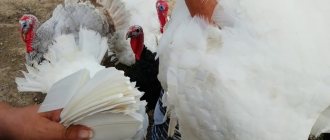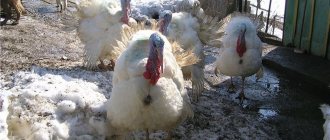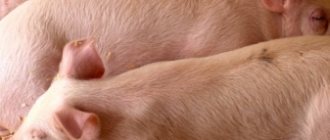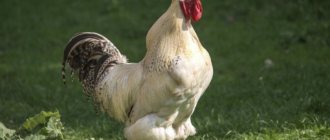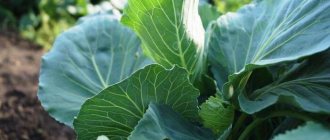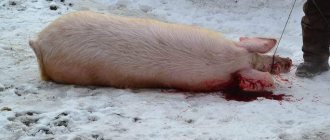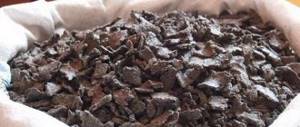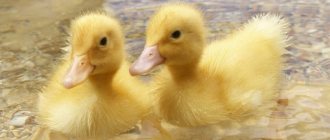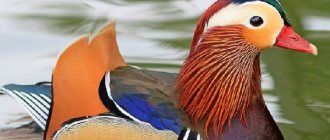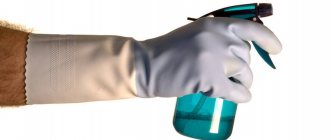Slaughter time for domestic ducks
Ducks are one of the fastest-growing birds raised in domestic settings. They gain body weight especially quickly when. A special diet of ducks, consisting of, allows you to get maximum profit with minimal investment in this business.
And how the bird was kept. If the ducks had free access to a pond with a sufficient amount of nutritious algae, then by eating these plants, the ducks grow literally before their eyes. The nutrients contained in algae are easily absorbed by the body of birds, and the resulting energy is spent on the growth of muscle mass. If you additionally give ducks a sufficient amount of grain in the morning and evening, they will grow a large liver, which can be used to prepare tasty, dietary dishes.
The age of ducks at the time of slaughter was not chosen by chance. 55 days is the optimal time to start slaughtering birds. The reason lies in the period of feather growth. Starting from day 60, ducks experience intensive feather growth, which leads to a decrease in the bird’s weight. A lot of energy is spent by the bird's body to ensure the growth of feathers. In addition, during this period it is the coarse, large feathers that grow, which adversely affects the presentation of the carcass.
How to properly slaughter ducks at home?
Immediately before slaughter, you should stop feeding the bird. On average, they stop giving food within 10-12 hours, and it is better to skip evening feeding. However, before slaughter, it is necessary to continue to provide the ducks with sufficient clean water to drink.
Many breeders, having started plucking feathers and down, are in no hurry to throw them away. You can place feathers in one container and fluff in another. Duck down is a valuable commodity that can be sold or used on your own farm. After plucking, the fluff must be cleaned from dirt in a soap solution. Next, you should treat it with ammonia, which will eliminate the smell of the bird and also have the effect of additional disinfection. After this, the fluff should be placed in a bag and dried in the fresh air.
Butchering a duck carcass
Cutting a duck carcass after slaughter can be divided into the following stages, namely:
Being independent only at the very beginning seems difficult, but with practice and getting used to it, it will be much easier to cope with this task. Beginning duck breeders may want to seek help from a more experienced breeder. However, if you follow the tips given in the article, you can very easily cope with the slaughter of ducks at home. Continue reading on the website
It is optimal to slaughter when the bird is 2-2.5 months old. By this time, individuals have built up a sufficient amount of muscle mass. Closer to 3 months, the growth of ducks practically stops, and the feathers, still young and immature, begin to coarse. You need to kill the birds before their feathers become too hard. This will make the carcass easier to pluck and will not lose its marketable appearance, which is especially important if the livestock was raised for sale. In addition, after 2.5 months, the meat may begin to acquire an unpleasant taste.
Before slaughter, the bird must be prepared - not at least half a day, but it is better to fast from the evening to the whole night. The restriction applies only to food; ducks must have free access to water at all times. Individuals that are planned to be slaughtered are separated from the main herd in a separate room and left with the light on all night. This is necessary so that the intestines are freed from excess contents.
The most convenient way to raise ducks at home is outside. To do this you need:
- hang the bird upside down by its legs, the wings should be laid one behind the other;
- holding your head, stretch your neck and cut the carotid artery with a knife;
- keep the carcass hanging for 15-20 minutes so that all the blood drains from it, after which you can start plucking.
When cutting the carotid artery, the knife should be held with a slight downward angle, and not perpendicular to the neck.
When can you slaughter a duck?
In total, more than a dozen breeds of these birds have been bred. Ducks are raised before slaughter both in private yards and on large farms. Among the most common breeds are the Pekingese, Musk, or Indochka, and Moscow White. Mulards, interspecific hybrids for meat production, deserve special attention.
Slaughter begins if the duck is at least 56 days old. The optimal average time is 60-75 days. During this time, individuals gain sufficient slaughter weight, their body is overgrown with a small layer of healthy fat. The turkey is slaughtered when its weight reaches 2-2.5 kg. The Mulard carcass should weigh 3 kg, and the Peking duck carcass should weigh at least 2.5 kg.
Expert opinion
Zarechny Maxim Valerievich
Agronomist with 12 years of experience. Our best country expert.
Ask a Question
If the purpose of breeding ducks is to obtain meat, it is important not to delay the deadlines and carry out slaughter in a timely manner.
At the age of 3 months, the growth of individuals slows down, and a change in plumage begins - molting. Immature and young feathers become coarser, become stiff, and stumps or tubercles appear on the skin of ducks. It becomes problematic to pluck a carcass properly after slaughter. The meat of an “overripe” domestic duck acquires an unpleasant aftertaste and becomes dry.
Plucking methods
Plucking should be done a couple of hours after slaughter. It takes time for the subcutaneous fat to harden so that damage to the skin during plucking will be minimal.
There are several plucking methods, but all begin by removing the largest feathers on the wings and tail. Movements should be smooth, not abrupt, to maintain the integrity of the carcass.
The dry method is a very popular method of plucking at home. To achieve the right result, strict consistency is important:
- The bird is placed on a large sheet of paper or a piece of cotton fabric. A container is placed nearby where the plucked feathers will be stored.
- The feathers on the chest, then the back and neck are removed by hand. The tail, legs and wings are processed last. You need to try to act carefully so as not to damage the skin. Otherwise, the skin will begin to spread, which will create inconvenience when plucking.
- After removing the feathers, tiny hairs always remain on the carcass. To remove them, you will need a knife - the blunt side of the blade is applied to the skin, the hairs are pressed against the blade with your thumb and quickly pulled out towards you.
- Sprinkle the duck with flour, rubbing it in in a circular motion. This will help remove excess moisture.
- To remove fluff, the bird is singed. Firing lasts a few seconds. Longer heating is dangerous due to melting of fat and charring of the skin. When singed, the duck straightens, the wings spread to the sides so that there are no difficult folds left. In this form, the carcass is carefully brought to the burner. During firing, soot often appears, which is then easily washed off along with the flour.
- After processing, the duck is thoroughly washed.
Hot method - for this method there is the following procedure:
- A bag made of durable fabric is soaked in hot water, then wrung out well. A bird carcass is placed there.
- The duck is kept in a carefully tied bag for 15 minutes.
- Next, the bird is ironed directly through the fabric of the bag.
- After this, you can remove and easily pluck the carcass.
Scalding – When using this method, the meat may change color due to heat treatment. A minimum of 4 hours must pass between slaughter and scalding. This method is especially convenient in cases where it is not possible to pluck the duck shortly after slaughter.
- The water heats up to 75-80 degrees. Steep boiling water is not suitable, since the skin may burst and it will be difficult to remove the feathers.
- The bird is completely immersed in a pan of hot water and remains there for 10-15 minutes.
- After the water is drained, the carcass is plucked and singed.
With any method, it is most convenient to pull out the feathers in the opposite direction from their growth.
Correct technology for cutting a duck carcass
From information on how to properly slaughter a duck at home, you can move on to the nuances of butchering a bird carcass.
This is done in the following order:
- Removal of the intestinal part of the entrails (performed through a hole made near the anus on the bird's body).
- Cutting off the neck, wings (it is advisable to carry out in the area of the initial joints) and paws (at a level of 20 mm to the bottom of the heel joint).
- Cutting the abdomen and further removing the internal organs.
- Removal of the digestive canal and crop (through a hole cut in the neck).
- Trimming fat deposits.
Further processing of the gutted carcass looks like this:
- Thorough rinsing under running water.
- Drying and freezing.
- If you want to cook a duck immediately after slaughter and plucking, you need to make cuts on the joints and be sure to remove the sebaceous gland in the loin part of the carcass.
Video: How to cut a duck into portions
Thus, killing a duck at home is not so difficult if you follow certain recommendations. You should also strive to do everything as carefully as possible so as not to damage the carcass and not get hurt yourself.
How to properly cut a duck?
Before gutting, the bird's neck is cut off. A hole is made near the anus to remove the intestines. Then they get rid of the paws and wings. The paws are cut off 2 cm above the heel joint, the wings are cut off at the first joint. After this, the belly is cut and the carcass is gutted. Abdominal fat, lungs and offal (liver, heart, stomach) are removed, which can later be used to prepare certain dishes. The crop and esophagus are pulled out through an opening in the neck.
After gutting, rinse well and allow to dry completely. It can be frozen if you do not intend to cook the meat immediately. If the bird is immediately used for cooking, then the second stage of cutting begins.
Domestic ducks provide not only feathers, but also tasty fatty meat. Slaughtering ducks at home can become one of the sources of income for you, especially since it is a simple matter. The main thing is to familiarize yourself with the nuances.
≡ Contents
How to kill a duck?
Several methods have been developed for killing domestic birds. The general condition is to drain all the blood from the duck being slaughtered. With insufficient bleeding, partial or complete redness of the skin occurs. Also, the remaining blood is a favorable environment for the emergence of pathogens. The breeder chooses the specific method of duck slaughter based on personal experience.
Artery dissection
The duck is hung upside down by its legs, the wings are firmly secured with rope or tape. The second option is to completely fix the duck in a special cone. Then they pull back the bird's neck and cut the artery in one sharp movement. The knife is not held perpendicular to the neck, but with a slight tilt forward. You can chop no more than 1-2 ducks at a time in this way, since the preparation is quite long.
| pros | Minuses |
| 1. Lack of labor effort. 2. “Purity” of the process. 3. There are no open wounds on the body. | 1. You can only slaughter 1-2 ducks per day. 2. Preliminary preparation (tying, fixing). 3. Knowledge of the anatomical structure of a duck. |
Using an ax
This is a traditional and common method for slaughtering birds at home quickly and easily. To kill a duck, it is placed on its side on a log or block. One wing becomes pressed to the block, the second is held by the farmer himself. The head is cut off with one blow of the ax, and in the next 2-3 minutes the duck is held until the death convulsions have completely passed. An ax or cleaver completely cuts the windpipe and blood vessels, and the bird dies instantly.
| pros | Minuses |
| 1. Speed and quick effect. 2. Simple technology. 3. The ability to kill a large number of ducks in a short time. | 1. Open cuts remain on the neck. 2. Risk of rapid spoilage of meat. 3. Severe death convulsions. |
Preparing a duck for slaughter
The duck should be quite plump; it needs time to develop pleasant-tasting meat. The best age for slaughter is 2 or 2.5 months. While the bird is growing, its plumage emerges, but at first it is not yet rough and not very hard. The feathers must grow back, but at the same time they are still young and immature, so that the bird is easier to kill and pluck, and then more enjoyable to feast on. If the slaughter date is missed, the poultry meat will acquire an unpleasant taste and will also look unsightly.
Before sending a duck to slaughter, it needs to be prepared. The preparation is simple, as they say, everything you need is simple, everything complicated is not necessary. Before slaughtering birds for meat, it is recommended not to feed them for half a day; you can fast them overnight. At the same time, they can be given water in any quantity. You need to place them in a separate room and turn on the lights all night. All these actions are necessary to ensure that the ducklings’ intestines are freed from unwanted (for the owners) contents.
It is most convenient to slaughter poultry using the external method. To properly slaughter a domestic duck, you should use the following plan:
- Take a duck intended for slaughter and hang it upside down by its legs. Lay down the wings. To make work easier, some specialists use a metal cone.
- You need to cut the carotid artery on the bird's neck. For convenience, the neck can be stretched.
- You need to wait 15-20 minutes: during this time, the duck carcasses will be drained of blood. After this, you can begin gutting.
You can watch the video to see more clearly how to kill a bird and gut it afterwards.
Plucking
Few people who keep their own ducks would disagree that plucking ducks is a very labor-intensive and tedious process. It should not be started immediately, but several hours after the birds have been killed. First they pluck the feathers on the tail and wings, then they begin to work on the chest part of the carcass. Before it’s time to pluck the carcass, you can sprinkle it with water: this way the feathers are better collected and do not scatter around the room. It is also recommended to distribute them in bags.
Most often, owners and housewives resort to this method. Before plucking a bird with it, you need to find a material or container for feathers: it can be a bucket, a basin, a piece of cloth. To avoid damage to the duck's skin, large feathers are torn out in the direction of growth, and small ones - against the direction of growth.
- They begin to pluck the carcasses from the chest and back, then gradually move on to the tail and wings. The main thing is that movements during work are neat and gentle, so as not to harm the skin;
- Before cutting up a bird, you need to remove all the feathers from the carcass, even the smallest ones. They do this in two different ways. The first is to pluck by hand: take a knife, apply it to the skin and remove the feathers with a movement towards yourself. The second method is scorching. To singe, straighten the duck so that there are no folds and bring it closer to the burner. The main danger is subcutaneous fat. The burner can melt it, which will ruin the appearance of the duck. The duck can still catch fire, so you need to handle it with care. At the end of the procedure, the duck is rolled in flour and washed.
At home, another method is also used for plucking: scalding. This is a simple method that only requires hot water and a carcass. The turkey is placed in a container of water, which is heated to 80°C. The duckling is turned from side to side to be scalded on all sides, at the end it is completely covered with water and left like that. After 10-15 minutes, the water is drained and plucked.
RAISING AND SlaughterING DUCKS
A little about raising and feeding ducks, and then a demon
Slaughtering a duck at home
Slaughtering and butchering ducks IN DETAIL! // Life in the village.
All our videos: https://goo.gl/3f9c4V The video was filmed on an sj camera
Another way to pluck a bird at home is the hot method. You need a bag that is soaked in hot water and wrung out. The duck is placed in this bag and then kept in it for 15 minutes. They iron the carcass without removing it from the bag, then pull it out and pluck it.
Preparing for plucking
The plucking is preceded by the slaughter of the duck. In households, the slaughter date is determined precisely by the condition of the plumage. The best moment is considered to be 60-65 days of life, when the covering has fully grown, but the flight feathers have not yet matured. For ease of removal, these feathers can be grown to 1-1.5 cm, so it will be easier to pick them up. However, the operation should not be postponed for more than 10 days. When the wing covering matures, it leaves behind a lot of stumps and stubble. The carcass will not be visually attractive.
Having decided on the day of slaughter, the bird is put on a starvation diet. For at least 12-16 hours, individuals feed only on water so that the crop, stomach and intestines of the carcass are cleaner. The duck spends the last night in the light, isolated from the flock.
12 hours before slaughter, the ducks only drink water and are not allowed to eat.
The easiest way to kill someone is after stunning them with a blow to the head. The body is suspended by the legs and the carotid artery is cut. The knife is held sharply, with a slight downward tilt. Then you need to keep the carcass in the same position over the bucket for about 10 minutes until completely bled. In the process, it is convenient to use special cones that do not allow the duck to lose its shape. When the blood has stopped flowing, you can begin to remove the feathers.
Butchering
Ducks are usually kept to be eaten or to sell their meat. Before you start gutting the bird, the intestines are pulled out of it by making a hole near the anus. This is the only way to increase the shelf life of carcasses in the refrigerator. The correct way is:
- Before cutting a duck, its neck is first cut off.
- Legs and wings are cut off.
- Finally, the cutting of the bird gets to the belly. It is opened and the giblets are taken out, which can then be used for various dishes. The goiter is removed through the hole in the neck and abdominal deposits are removed. After the bird has been gutted, it is washed under running water and frozen. It is advisable not to chop tubular bones, so as not to spoil the dish with fragments.
This is followed by cutting the bird into portions. The storage method differs depending on how many days the bird needs to be preserved. The carcass can be stored for some time at 0 - 4°C, but for long-term storage it must be placed in the freezer.
A good option for long-term storage is pickling.
The amount of saline solution depends on how much weight the bird is pulling.
Cutting and plucking methods vary depending on the context: what the meat is intended for. There are also nuances to the methods of killing ducks. If a friend stabbed her to death using some other method, it’s worth familiarizing yourself with it. Standard duck slaughter is given in the article. Birds are often killed in their sleep.
Duck is a tasty bird, and no matter what method of slaughter you choose, its meat will always please you.
Before slaughter, the birds are well fed. The optimal period for fattening is 2 months. During this time, the meat becomes more palatable. Before the process itself, the animals are prepared - they are not fed for 6-10 hours, but they are given plenty of drink. It is better if the bird is left without food at night.
In the barn where the ducks are located, the lighting must be turned on. These rules are followed so that their intestines are freed from the remaining food.
Duck slaughter
The slaughter of birds is carried out in the same way as for geese - by the external method. This method is considered simpler and more reliable, as it ensures better blood drainage from the carcass.
The time for slaughter is most often determined by the type of feathers. The best moment is when the feather is considered fully grown, but still immature. Otherwise, the moment to pin the animal will be missed. The carcass will acquire an unpleasant aftertaste and lose its former appearance.
Butchering a duck
Let's look at how to properly cut a duck below. To begin with, all the intestines are removed through a specially made hole near the anus. It is especially important to carry out this procedure if the bird is expected to remain in the refrigerator for a long time. The further process of cutting a duck at home is as follows:
- Before gutting a bird, its neck is cut off;
- further, the wings and paws are separated, the legs are cut off 20 mm below the heel, and the wings are cut off at the initial joint;
- then the belly is cut and the carcass is gutted (the internal organs are removed, which can later be used to prepare broths or minced meat);
- the esophagus and crop are removed through an opening in the neck;
- abdominal fat deposits are also removed.
Gutted samples are thoroughly washed under running water, dried and frozen. If the duck is intended to be used immediately for preparing certain dishes, the second stage of cutting begins.
To avoid small bones getting into the food and maintaining the integrity of the pieces, you need to feel the joints and make cuts.
First of all, the hams are separated using a special knife, trying to grab the meat as close to the back as possible. The wings are disconnected in the same way, making the grip as close to the vertebra as possible.
Duck carcass cut lengthwise
The sirloin part of the carcass is cut along the body. The ribs and tail of the house can be cut off with scissors. The fillet is usually divided into several parts, after removing the sebaceous gland, damage to which can spoil the taste and aroma of the meat.
As a result, what should remain is the spine and skin, which is cut off and melted along with the fat. The ridge is used to prepare first courses.
It is worth noting that wild duck can be cut using the methods presented above. However, during the process it is necessary to carefully examine the carcass for the presence of pellets.
Stages of slaughter
Most often, slaughter is carried out using the standard method:
- The birds are tied by the legs so that the carcass hangs head down. Some use a special metal container in the shape of a cone.
- The wings overlap each other.
- The feathered neck is pulled out and cut in the area of the carotid artery. The knife blade is directed under the jaw.
- Wait for up to 20 minutes. This is enough to completely drain the body of blood. Only after this can plucking and cutting begin.
Processing meat at home does not bring pleasure to every person. But if you follow a certain plucking algorithm, you can get rid of the plumage very quickly.
Slaughter
The most convenient time to slaughter a bird is 2-2.5 months after the birth of the bird. At this time, it is covered with the first plumage, which should not be rough. For this procedure, the bird is pre-prepared. Experts advise not to feed pets 12-16 hours before slaughter; they can drink unlimited amounts of water.
The best way to kill a duck is externally, especially at home. Alternatively, you can use the following method:
- the bird is suspended by its legs, head down, with its wings folded one after the other. You can use a metal cone-shaped container;
- the neck is stretched and the carotid artery is cut with a knife;
- after 15-20 minutes the carcass will be completely drained of blood, after which the duck is plucked and cut up.
Two-month-old ducks are already fit for slaughter
Dry processing method
This method is considered the most common among housewives. Its use is optimal immediately after slaughtering the bird.
- The carcass is placed on your lap. It is better for the duck's head to hang down.
- A bowl is placed nearby where cleaned fluff and feathers are placed.
Dear visitors, save this article on social networks. We publish very useful articles that will help you in your business. Share! Click!
- They start plucking feathers from the chest, then move to the back. Next, pluck out the tail and wings. All movements must be as careful as possible so that the skin of the duck is not damaged. Destroyed skin spreads very quickly, and this creates inconvenience during further processing.
- To ensure that the bird is fully cooked, small hairs are also removed before cutting. It is impossible to do this with hands alone. You must use a knife. The blunt side of the knife is applied to the carcass and held with the thumb. With a sharp movement, the feathers are plucked towards themselves. Some people prefer to use singeing instead of manually processing the carcass to remove small feathers.
- You need to singe the carcass carefully so that the duck does not catch fire. It is first straightened without leaving a fold on the skin, and the wings are turned to the sides. In this position, the animal is brought to the burner. It is important not to melt all the subcutaneous fat. Because of this, the leather is damaged and the product loses its appearance. The soot that appears is not scraped off, because it will fall off on its own during rinsing.
- The meat is then dredged in flour to remove any remaining moisture.
- The bird is thoroughly washed under running water.
You can pluck meat at home in other ways.
Cutting technique
Before cutting the carcass, it should be gutted. A longitudinal incision is made in the abdomen using a sharp knife and all the entrails (offal) are removed. This is the first step if a person plans to place the bird in the refrigerator for some time. Gutted lungs, stomach, and liver should not be thrown away; they are used for preparing first courses.
Proper slaughter of ducks at home and cutting them up consists of several stages:
- before gutting, the neck is cut off from the carcass;
- Next, the wings are cut off, the legs are just below the heel joint, and the wings are cut off at the junction with the initial joint;
- the esophagus and goiter should be gutted through the cervical opening;
- fat deposits that have formed in the abdomen are cut out.
The first step is to remove the intestines. This procedure is important, especially if you plan to send the duck for freezing.
After gutting is completed, the carcass is thoroughly washed in several waters, dried, and stored entirely in the refrigerator or freezer. If the housewife has slaughtered a duck and is going to cook it immediately after gutting, it is important to properly cut it into portioned pieces. The first step is to feel the joints and make cuts at their joints. This will prevent the risk of bones breaking during cutting and getting into your food.
You can cut a duck in the following way:
- First, use a knife to separate the hams, making a greater grip on the meat on the back.
- In the same way, you need to cut the wings closer to the vertebrae.
- The brisket should be cut along the body.
- Use kitchen scissors to cut the tail and ribs.
- The fillet is divided into several parts, having previously been freed from the sebaceous gland, which worsens the taste of the meat.
- After cutting, there will be one frame with a skin that is cut off. The frame is not thrown away; it is better to chop it into pieces or leave it whole, and then use it to prepare broths and other first courses.
When to cut ducks to avoid stumps? This question interests novice breeders. After all, if you slaughter ducks at home and do not determine the timing correctly, the carcass will lose its presentation, and its plucking and cutting will take a lot of time. Advice from experienced poultry farmers, reviews, and videos will help you correctly determine the optimal timing for slaughtering ducks.
Cutting rules
To properly cut a duck at home, you need to follow some rules. The neck is removed first. Some of the meat is left in front to cover the cut. This is necessary when preparing stuffed poultry.
Next the legs are cut off. The incision is made 2 cm above the heel joint. The wings are cut off at the first joint.
The belly of the carcass is ripped open and all internal organs are removed. The goiter is removed through the cervical opening. After removing the internal organs, the meat is washed under running water. It is important to rinse quickly to avoid losing nutrients.
It is advisable to leave the tubular bones of the bird whole so that small pieces do not end up in prepared dishes. Incisions are made in the joints:
- The thighs are separated with a sharp knife;
- the wings are separated using incisions near the spine;
- to cut the fillet parts, lay the bird on its back;
- the ribs are removed using kitchen scissors;
- Before cooking, it is important to remove the sebaceous gland so as not to spoil the taste of the dish.
Cutting Tips
Domestic duck can be cut using a developed algorithm. The first step is to carefully cut off the neck, leaving a piece of skin to disguise the cut/wound. Then they work with the legs and wings of the duck. The paws are cut off at a distance of 2-4 cm from the heel joint, the wings are cut off at the first joint.
Next, the belly is cut and all the giblets are removed. The stomach and lungs are washed and stored separately. Be sure to cut off the abdominal fat and the coccygeal (sebaceous) gland in the back. These elements often spoil the taste of duck meat when cooked. The crop and esophagus are removed through an incision at the bottom of the neck. After this, the duck is thoroughly washed and dried, the carcass is ready for storage.
Duck slaughter is an important process, the technology of which every bird breeder should be familiar with. Slaughter begins when the individuals are 60-70 days old. At this time, their meat is tender and dietary, there are no fatty growths.
If you delay the delivery, the quality of the carcass will deteriorate: hemp will appear and the meat will become tough. The most popular techniques for slaughtering ducks are cutting off the head or cutting the artery.
When raising ducks, breeders follow the rules of such farming. One of the important stages is the slaughter, plucking and cutting of the duck. At home, several methods of such processing are used.
- Slaughter time
- Slaughtering technique
- Plucking methods
- Dry plucking
- Hot plucking
- Plucking in a bag
- Cutting technique
- Conclusion
Meat storage
After the poultry has been slaughtered and cut up, the question arises about the rules for storing carcasses. Short-term storage requires a temperature of 0-4 degrees. If there is no refrigerator nearby, then the meat is wrapped in clean cotton cloth. This way the product will remain fresh for up to 5 days.
For long-term storage you will need a freezer. The product can also be preserved by salting. The brine is prepared from 1 liter of water and 300 g of salt, and then poured into the carcass. One piece will require 150 g of liquid.
The poultry farmer independently determines the method of processing meat, depending on taste preferences and further use of the product. For short-term storage, it is optimal to use scalding, and for long-term storage, the dry method.
Ducks are slaughtered before they begin to moult. Otherwise, processing will require much more effort.
And a little about secrets...
Have you ever experienced unbearable joint pain? And you know firsthand what it is:
- inability to move easily and comfortably;
- discomfort when going up and down stairs;
- unpleasant crunching, clicking not of your own accord;
- pain during or after exercise;
- inflammation in the joints and swelling;
- causeless and sometimes unbearable aching pain in the joints...
Now answer the question: are you satisfied with this? Can such pain be tolerated? How much money have you already wasted on ineffective treatment? That's right - it's time to end this! Do you agree? That is why we decided to publish an exclusive interview with Professor Dikul, in which he revealed the secrets of getting rid of joint pain, arthritis and arthrosis.
